Rosy Boa
Lichanura trivirgata, Lichanura orcutti
One of the few snakes that naturally comes in a rainbow of colors!
Advertisement
Rosy Boa Scientific Classification
- Kingdom
- Animalia
- Phylum
- Chordata
- Class
- Reptilia
- Order
- Squamata
- Family
- Boidae
- Genus
- Lichanura
- Scientific Name
- Lichanura trivirgata, Lichanura orcutti
Read our Complete Guide to Classification of Animals.
Rosy Boa Conservation Status
Rosy Boa Facts
- Prey
- Mice, baby rabbits, kangaroo rats, pack rats, birds, lizards
- Main Prey
- Mice and rats
- Name Of Young
- Neonate
- Group Behavior
- Solitary except during mating season
- Fun Fact
- One of the few snakes that naturally comes in a rainbow of colors!
- Estimated Population Size
- Unknown, but likely over 10,000
- Biggest Threat
- Collectors
- Other Name(s)
- Coastal rosy boa, Mexican rosy boa, Baja rosy boa
- Litter Size
- 2-15
- Lifestyle
- Nocturnal/Crepuscular
- Common Name
- Rosy Boa
Rosy Boa Physical Characteristics
- Color
- Brown
- Grey
- Black
- White
- Cream
- Orange
- Chocolate
- Skin Type
- Scales
- Lifespan
- 18+ years
- Age of Sexual Maturity
- 1-2 years
- Venomous
- No
- Aggression
- Low
View all of the Rosy Boa images!
The rosy boa is one of two boa species native to areas of California, Arizona, Nevada, and Mexico.
A shy, reclusive species, the rosy boa is a popular pet thanks to its calm temperament and beautiful colors. It is a smaller cousin to the much larger red tail boa that lives in South America. Like their bigger cousins, rosy boas are nonvenomous constrictors.
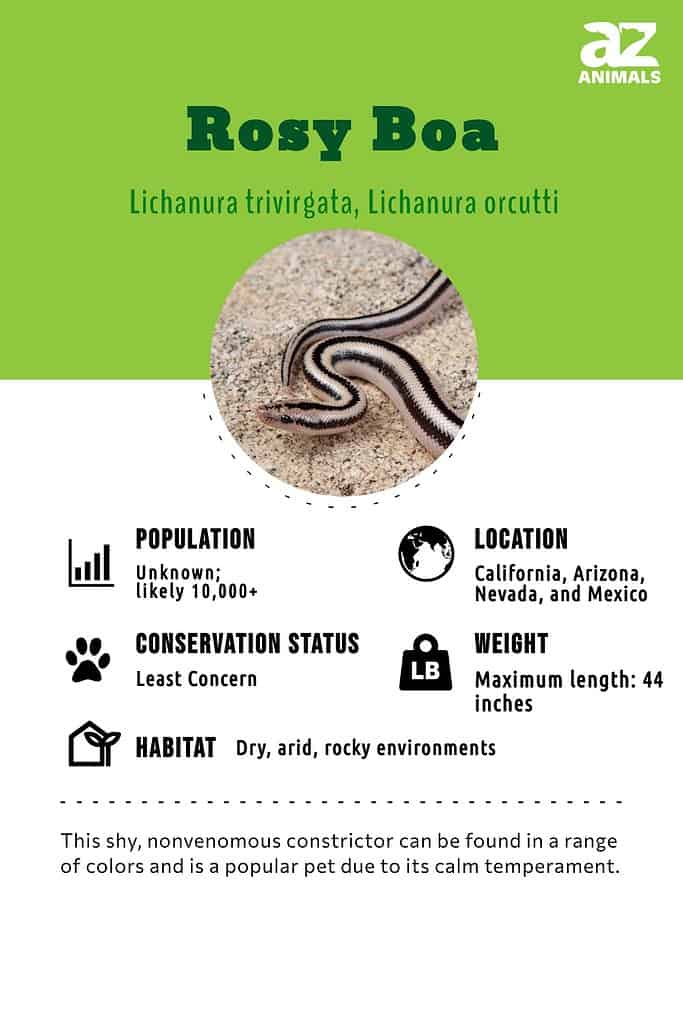
3 Amazing Facts About Rosy Boas
- This species comes in several color palettes, depending upon which area it inhabits (called a locality).
- After mating in the spring, females give birth to 2-15 babies after in late Summer or early Fall.
- Rosy boas’ calm temperament makes them a terrific first snake as a pet, and they’re easy to get from breeders.
Scientific Name and Types of Rosy Boas
Until the early 2000s, scientists recognized one species (Lichanura trivirgata), with four subspecies. They included the desert rosy boa, coastal rosy boa, the Baja rosy boa, and the Mexican rosy boa.
When scientists did more research and genetic testing, they determined that there were two main species and reclassified the northern group into Lichanura orcutti, leaving the southern group in Lichanura trivirgata.
Its genus name, Lichanura, originates in two Greek words: lichanos meaning forefinger, and oura referring to the tail. This could be a reference to this snake’s body shape. The specific epithet of trivirgata means three-lined, while orcutti refers to a San Diego naturalist Charles Orcutt, who collected specimens that became the holotype of several species.
Even though scientists reclassified them into two species, these boas still go by their common names that generally refer to their locality. It makes understanding which type you are looking at a little more difficult, but not impossible. Many herpetologists continue to dispute the rosy boa’s taxonomy and others do not accept the classifications of subspecies as valid.
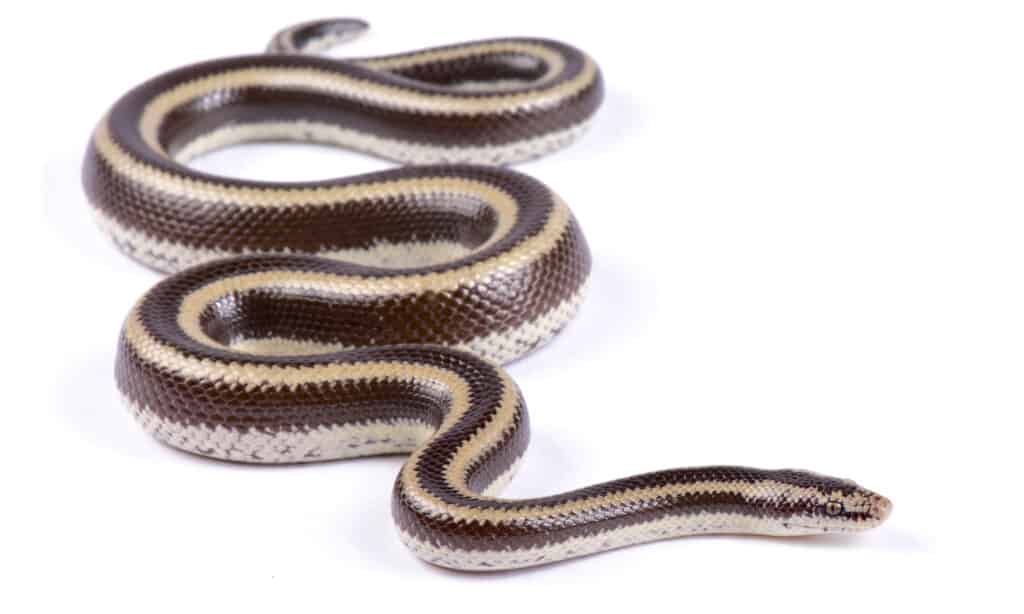
The rosy boa’s genus name, Lichanura, originates in the Greek words for forefinger and tail.
©reptiles4all/Shutterstock.com
Evolution and History
Showing its evolutionary relationship to the lizard, another member of the Squamata Order, the rosy boa has two functional lungs (typically snakes have one lung) and has a kind of pelvis in its vestigial hind limbs, or claw-like spurs, that are located close to its vent.
An evolutionary adaptation to its environment is that this snake is fossorial, meaning it can dig or burrow, and spends its time under rocks as well as using rodent burrows for shelter.
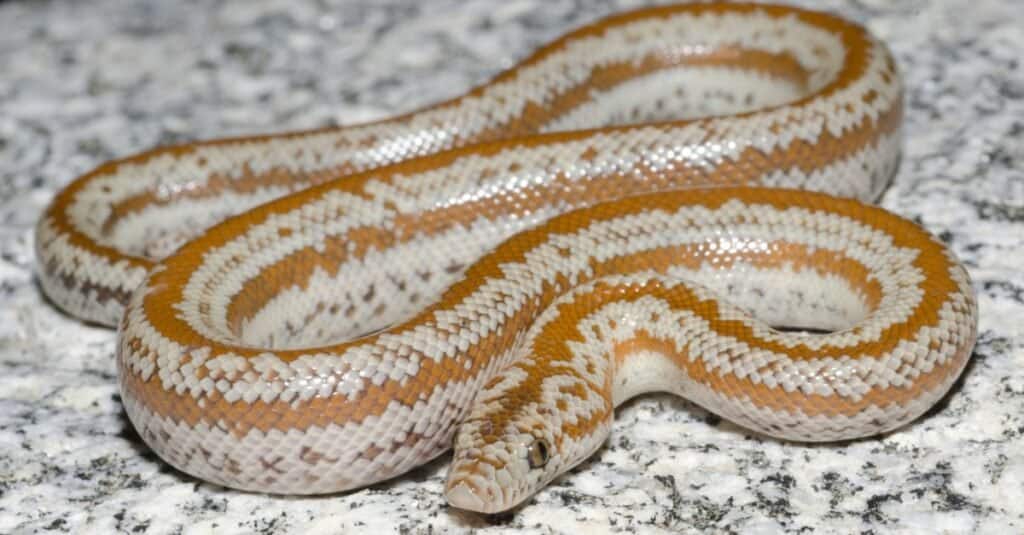
The rosy boa has two functional lungs like lizards, another member of the Squamata Order.
©Jason Mintzer/Shutterstock.com
Appearance
Rosy boas have a wide range of colorations but have several things in common. The first is that they stay smaller than most boas; the largest of them won’t exceed 44 inches long. All subspecies have stripes running the length of their body; however, some localities have more definition and contrast in the stripes. For example, the coastal rosy boa has a more speckled appearance, and its stripes aren’t as clearly defined as the Mexican subspecies.
In general, this snake is slow-moving, not at all aggressive, and boasts some of the prettier boa color colors. While they are smaller, like the sand boas, they have a more traditional “boa head” than do the sand boas. Rosy boas have elliptical pupils and eyes that match their body color. Some localities have rose or pink-colored bellies, which is where they get their common name.
This species has a thick, muscular body and smallish head, and most don’t get very bitey, even if you catch it in the wild. That’s not to say that you should capture one and take it home, they’re protected under Federal statute as a species of special concern. This species is popular as a pet and widely available from breeders.
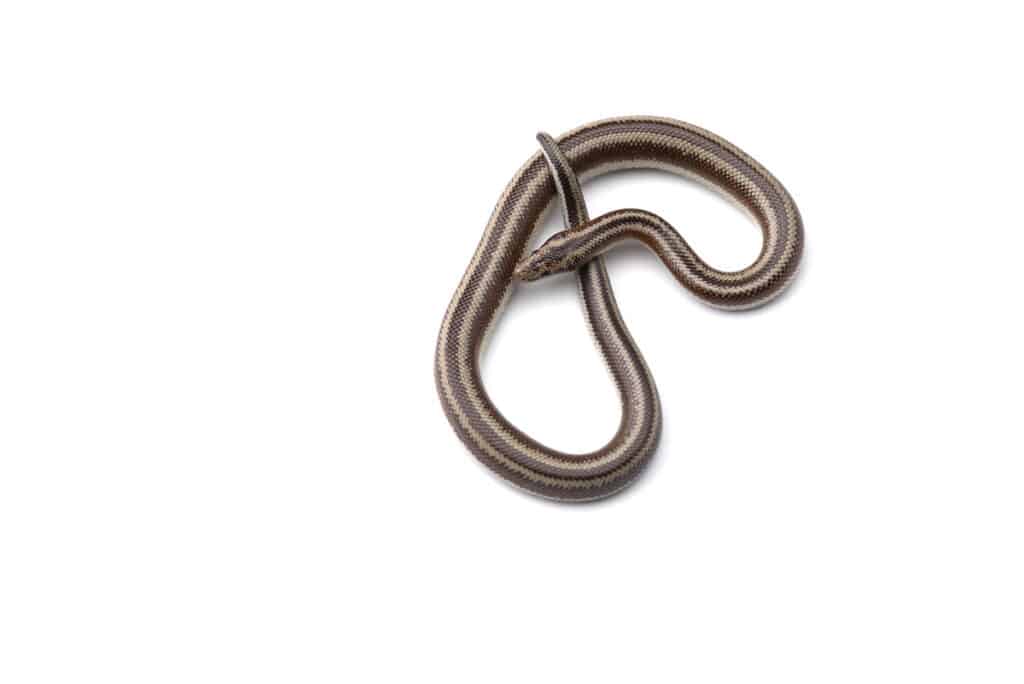
The rosy boa is smaller than most boas and grows to 44 inches at most.
©PetlinDmitry/Shutterstock.com
Behavior
It’s nocturnal during the hot summer months, but when the weather is cooler in Spring and Fall you might find one wandering about in the late afternoon and early evening. This boa is also found at night crossing roads while on its way to the next rocky crevice for shelter and hunting.
Rosy boas are fossorial much of the time and tend towards hiding under things instead of hanging out in the open. This species isn’t known for climbing, but it can climb when the need arises.
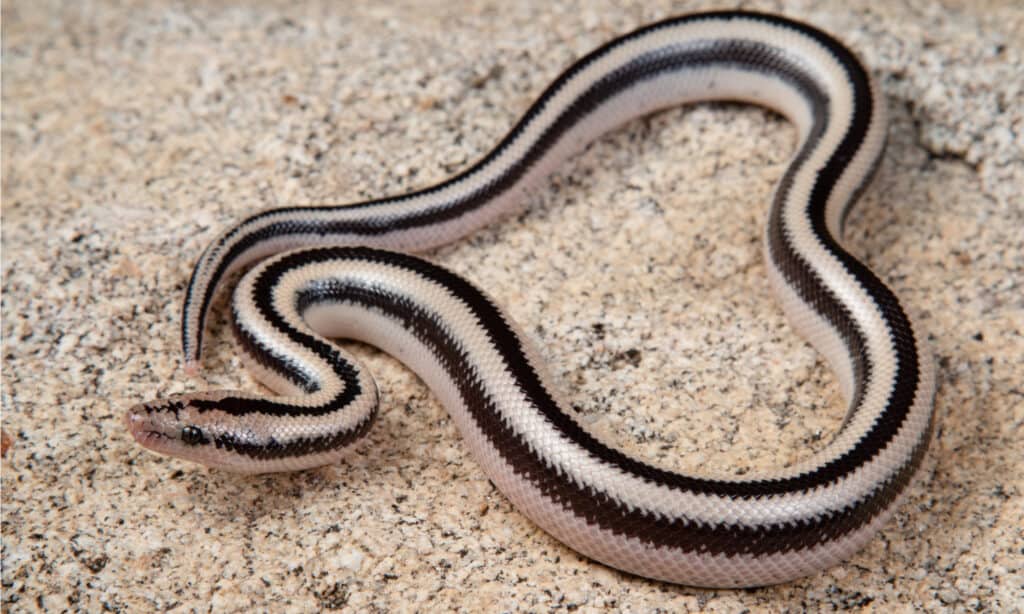
The rosy boa can be seen at night seeking out its next rocky crevice to shelter under.
©Nathan A Shepard/Shutterstock.com
Is a Rosy Boa Dangerous?
Rosy boas are one of the most mild-mannered snakes you can encounter, and even if one does try to bite you, it’s not a venomous species. This snake is not dangerous and is much loved by many field herps.
Even though they don’t move quickly, rosy boas will attempt to escape before biting. In fact, you’re more likely to have this snake musk you than bite you.
Due to its calm temperament, this snake makes a popular pet and is one of the easiest snakes for beginners to care for. It is one of the safest snakes to handle, both in captivity and wild. However, it’s a protected species in some places, so it’s best to know your area’s laws.
Habitat
This desert-dwelling boa loves dry, arid conditions like those found in southern California, Arizona, Nevada, and northern Mexico. The rosy boa prefers granite outcroppings, although it also takes advantage of debris left behind by people.
Diet
These snakes eat rodents like pack rats, deer mice, kangaroo rats, and baby rabbits; however, they may also eat other animals such as lizards and birds.
This snake is an ambush predator that grabs rodents and small mammals when they get close enough to snatch. After the boa immobilizes the animal, it quickly wraps its coils around it and squeezes until it becomes incapacitated so the snake can swallow it whole.
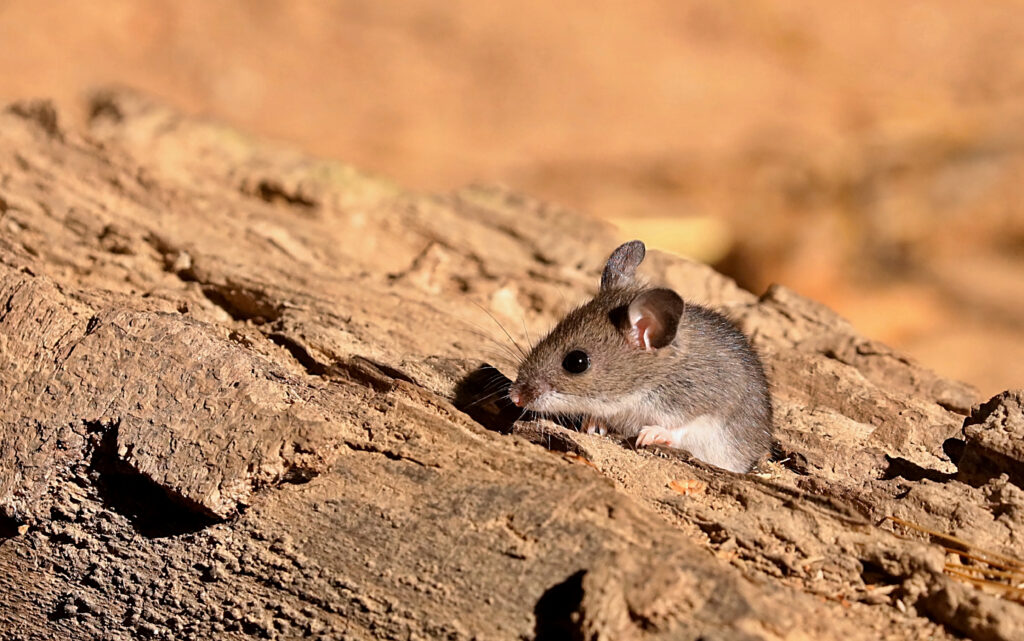
Rosy boas eat rodents such as the eastern deer mouse.
©jitkagold/Shutterstock.com
Reproduction and Lifespan
In the spring this species goes looking for a mate. When a female is pregnant, she will carry them for about 5-6 months before giving birth to 5-10 babies in late Summer or early Fall. Once born, the mother’s role is over and these snakes become instantly independent. Within 2-3 years, the rosy boa reaches maturity.
The average lifespan of a rosy boa in the wild is unknown. Generally, rosy boas can live from 18 to 22 years in captivity, with some recorded to reach more than 30 years old.
Predators and Threats
Like many snake species, the rosy boa’s potential predators include carnivorous mammals such as coyotes, raccoons, ringtails, skunks, and weasels. Bird species including hawks and shrikes, and other, larger, more aggressive snakes such as king snakes are also likely predators.
The rosy boa’s defense mechanism when facing threats is to roll itself into a ball, protecting its head and moving its tail as a distraction. The snake will also release a strong musky substance from its cloaca.
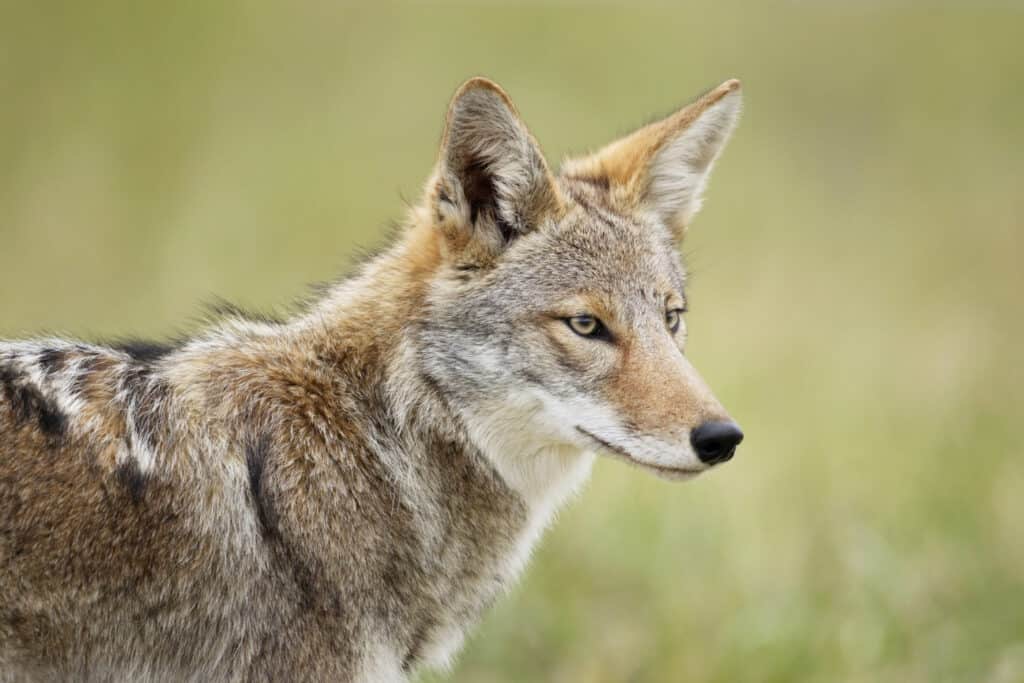
The coyote is one of the rosy boa’s predators.
©Paul Tessier/Shutterstock.com
Conservation and Population
They’re listed in the IUCN Red List as Least Concern; however, according to the IUCN both Lichanura species’ (rosy boa and three-lined) populations appear to be decreasing. Their actual population size is unknown; scientists believe it may exceed 10,000 adults per species. What scientists do know is that some areas that are easily accessed by collectors have seen a marked decrease in the wild population. In contrast, they’re much more abundant in more remote areas like Organ Pipe Cactus National Monument.
There isn’t as much information on Mexican population numbers, but given that collectors have taken a toll in U.S. areas, it’s likely that this is the case in Mexico.
While this species is lovely to see in the wild, observers should ensure that specimens aren’t removed from the environment. Given that its wild numbers are decreasing and it is widely available from breeders, there’s no reason to be out collecting this snake.

The IUCN lists the rosy boa as Least Concern although the population is decreasing.
©Tobias Arhelger/Shutterstock.com
Rosy Boa FAQs (Frequently Asked Questions)
What do rosy boas eat?
These snakes eat various small mammals including mice, baby rabbits, and kangaroo rats. They also eat birds and lizards.
How do they hunt?
They’re painfully slow, so hunting down their prey probably isn’t easy. They’re ambush predators that wait for their food to come to them.
Are rosy boas dangerous?
No, not at all! This snake is a harmless constrictor whose best defense is to escape or musk you.
How big do they get?
Coastal rosy boas can be up to 44 inches long, but the other species average 2-3 feet long.
Thank you for reading! Have some feedback for us? Contact the AZ Animals editorial team.
Sources
- Rosy Boa | IUCN Redlist / Published April 5, 2016 / Accessed May 6, 2022
- Northern Three-lined Boa | IUCN Redlist / Published April 6, 2016 / Accessed May 6, 2022
- HerpWiki / Accessed May 6, 2022
- California Herps / Accessed May 6, 2022


















